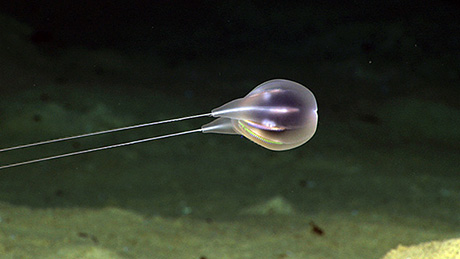What's Happening at Discovery Diving
Get all the latest info from our Instructors and Staff on our SCUBA Classes, Charters, Equipment and Special Events.
Océano Profundo 2015: At The Bottom of the Caribbean
- Font size: Larger Smaller
- Hits: 1341
- 0 Comments
- Subscribe to this entry
- Bookmark
With measured precision remotely operated vehicles D2 and Seirios are lowered into the deep blue waters of the Caribbean. Ready for the unknown, they begin the descent through the water column to the seafloor hundreds of meters below.
February 18 marked the beginning of NOAA’s first expedition for this year – Océano Profundo: Caribbean Trenches and Seamounts – with the express purpose of exploring little to unknown regions around Puerto Rico and the U.S. Virgin Islands. (For more information visit my previous article Exploring the Ocean with the Okeanos Explorer or visit OceanExplorer.noaa.gov). The expedition was divided into three parts where one and two consisted of 24 hour mapping with the Okeanos’ multibeam sonar around the EEZ of Puerto Rico and the Virgin Islands. The third leg, just recently concluded, scheduled 20 dives with D2 and Seirios in order to capture visual footage and explore deep water habitats. During this leg days on the Okeanos were full, exploring by day and mapping at night.
Due to mechanical issues with the ship, only 12 of the 20 dives were able to be performed. But, as on-board scientist Andrea Quattrini, so aptly put it, “12 is better than none.†Quattrini, a postdoctoral researcher of the U.S. Geological Survey, represented the biological science lead during this expedition. Accompanying her with a geological perspective was Mike Cheadle, associate professor of geology at the University of Wyoming.
The first dive was conducted on April 10, targeting the Arecibo Amphitheater just north of San Juan. Beginning at a depth of 4,058 meters, D2 imaged carbonate and sandstone rocks which were part of an unknown escarpment, while simultaneously viewing a plethora of marine life. Further dives were conducted on Mona Seamount and Mona Canyon, relatively west and northwest of Puerto Rico. On dive 6 they explored platform carbonate at a depth of nearly 600 meters just off the continental shelf.
As can be expected, life in these depths were more prominent resulting in high diversity of corals, sponges, and fishes. It was on this dive that the only queen snapper of the entire expedition was seen. They proceeded to explore the east wall of Guayanilla Canyon before making port in San Juan for repairs.
On April 25, the ROV team took a special dive not far from the port of San Juan to a depth of 1670 meters in order to practice using the D2’s newest manipulator arm underwater. There are expectations for further use during NOAA’s next expedition in the Pacific.
The next dive consisted of a brief visit to the Puerto Rico Trench, D2’s deepest dive since the beginning of its career in 2013. Irregularities with the hydraulics prevented any further exploration, but by the next day D2 and Seirios launched into shallower depths to explore sonar anomalies discovered by NOAA sister ship, Nancy Foster. The anomalies were described as mounds consisting of iron manganese-coated carbonate rubble whose origin is still unknown, though theories have been made. Over 26 species of coral was observed on these mounds with a good quantity of associates differing with depth. Notably, most of the species of biota observed on this dive were new to the expedition.
As the expedition drew to a close, the team performed its last two dives near the St. Croix Basin and Whiting Seamount, southeast of Puerto Rico. During dives 4, 5, and 11, they conducted mid-water transects where both ROV’s were paused in the water column for short periods to observe pelagic organisms. They were rewarded with excellent imagery of various siphonophores, jellyfish, and mid-water fishes, as well as a visit by a “friendly†squid measuring between 1.5 and 2 meters.
The information gathered is now being carefully processed and documented for further study. And although we are saddened to have come to the end of this expedition, the Okeanos is already preparing for its next expedition in the Pacific where more unknowns await!
Images courtesy of NOAA Okeanos Explorer Program, Océano Profundo 2015: Exploring Puerto Rico’s Seamounts, Trenches, and Troughs.


